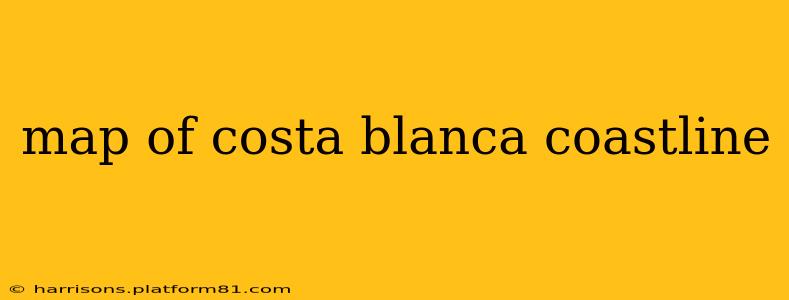The Costa Blanca, meaning "White Coast" in Spanish, stretches along the southeastern coast of Spain in the Valencia region. Known for its stunning beaches, charming towns, and beautiful countryside, it's a popular destination for tourists and expats alike. This guide provides a detailed overview of the Costa Blanca coastline, using maps and information to help you plan your perfect getaway.
What Makes the Costa Blanca Coastline So Special?
The Costa Blanca boasts over 200 kilometers of breathtaking coastline, offering a diverse range of landscapes. From dramatic cliffs and hidden coves to expansive sandy beaches and vibrant marinas, there's something for everyone. The area's consistently warm, sunny climate, averaging over 300 sunny days a year, adds to its allure. The region is also home to several natural parks, offering opportunities for hiking, cycling, and exploring the unique flora and fauna of the area.
The cultural richness of the Costa Blanca is equally captivating. Numerous charming towns and villages, each with its own unique character and history, dot the coastline. From the bustling city of Alicante to the quieter, more traditional towns inland, there’s a wealth of cultural experiences to be had. This includes exploring historical sites, indulging in delicious local cuisine, and experiencing the vibrant Spanish culture.
A Detailed Look at the Costa Blanca Map
While a simple map can show the coastline's general shape, understanding the nuances requires a more detailed approach. Consider using an interactive online map, which allows for zooming in on specific areas to explore towns, beaches, and points of interest. Look for maps that include:
- Major Cities and Towns: Alicante, Benidorm, Calpe, Denia, Jávea – these are key locations to consider when planning your itinerary.
- Beaches: Identifying specific beaches, their size, accessibility, and amenities (like parking, restaurants, water sports facilities) is crucial for beach lovers.
- Natural Parks and Protected Areas: These areas often offer stunning hiking trails and opportunities to experience the natural beauty of the Costa Blanca.
- Points of Interest: Historical sites, museums, viewpoints, and other attractions are best identified on a detailed map.
You can find excellent maps on sites like Google Maps, Bing Maps, or specialized travel websites focusing on Spain and the Costa Blanca region. Many travel guides also provide detailed maps within their pages.
Where are the best beaches on the Costa Blanca?
The Costa Blanca boasts a diverse array of beaches, catering to various preferences. Some of the most popular include:
- Alicante's Postiguet Beach: Located right in the city center, this urban beach offers easy access and a lively atmosphere.
- Benidorm's Levante Beach: Known for its fine sand and wide expanse, this is a popular spot for families.
- Calpe's Playa de la Fossa: A beautiful sandy beach backed by the iconic Peñón de Ifach rock.
- Jávea's Granadella Cove: A stunning cove with crystal-clear waters, perfect for snorkeling and swimming.
However, the "best" beach depends entirely on individual preferences. Some prefer the lively atmosphere of a large urban beach, while others seek the tranquility of a secluded cove. Use a detailed map to explore the different options available and choose the beach that best suits your needs.
What are the main towns and villages to visit on the Costa Blanca?
Exploring the charming towns and villages along the Costa Blanca is a significant part of the experience. Each offers a unique character and cultural heritage:
- Alicante: The region's capital, offering a mix of historical sites, modern amenities, and a vibrant nightlife.
- Benidorm: A bustling tourist resort town known for its high-rise hotels, beaches, and amusement parks.
- Altea: A picturesque town with whitewashed houses, cobbled streets, and stunning views.
- Jávea: A beautiful coastal town with a mix of sandy beaches and rocky coves.
- Denia: A historic port town with a lively marina and a rich cultural heritage.
These are just a few examples; numerous other smaller villages offer equally captivating experiences. Using a map, you can discover hidden gems and plan your route based on your interests.
What activities are available on the Costa Blanca?
The Costa Blanca offers a wide range of activities to suit every taste:
- Water Sports: Swimming, sunbathing, snorkeling, diving, windsurfing, kitesurfing, and boat trips are all popular activities.
- Hiking and Cycling: The region's diverse landscape provides ample opportunities for exploring the countryside on foot or by bike.
- Cultural Tourism: Visiting historical sites, museums, and local markets offers a chance to experience the rich culture of the region.
- Gastronomy: Indulging in the delicious local cuisine, including fresh seafood and traditional paella, is a must.
- Nightlife: From lively bars and clubs in Benidorm to quieter tapas bars in smaller towns, there's something for everyone.
Remember to use a map to plan your activities and ensure you have the necessary information to reach your desired destinations.
This guide provides a starting point for exploring the beautiful Costa Blanca coastline. With a detailed map as your companion, you’re well-equipped to plan an unforgettable trip filled with stunning beaches, charming towns, and exciting activities. Enjoy your journey!
